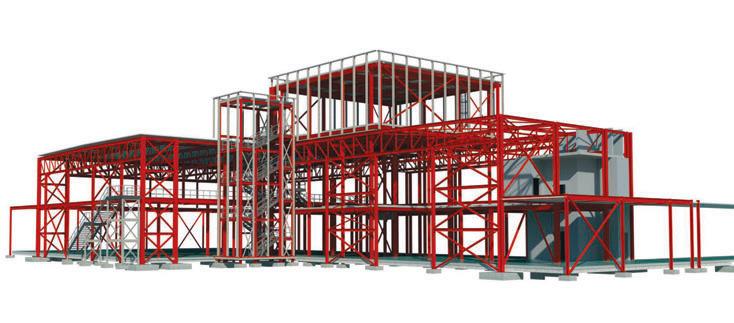Feature
Into the fold Using robots to bend, shape and fold sheet metal is adding freedom to architectural façade designs. Stephen Holmes visits Robofold and becomes transfixed by robotic origami. Right From its factory in South London, Robofold can produce exciting shapes without the need for tooling Below Zaha Hadid Architects’ Arum sculpture for the Venice Biennale — a six metre high, tulip shaped, self-supporting structure
I
n the metallic arms of a pair of assembly robots an evolutionary change in architectural cladding is underway. At Robofold’s South London headquarters two 6-axis ABB robots are moving in tandem, gliding into their pre-programmed positions, their suction cups attaching to a sheet of pre-cut aluminium. They arch and twist till the metal is bent and precisely formed into a giant petal, a replica of the one displayed on the screen of the nearby controlling laptop. This process is capable of creating individual cladding panels — something that until now has been too expensive and time consuming. With tools that can now liberate the form of each and every individual panel, architects can transform the overall shape of building façades using Robofold’s design and manufacturing technique.
Robots rock The system works off a plug-in for designs built in Rhino 3D CAD with the software coding developed by Robofold. 24
May / June 2014
p24_25_AEC_MAYJUNE14_Robofold.indd 24
The designs are translated into folding simulations in the King Kong software. In turn these results are linked to the Godzilla robot software, to simulate robots folding, before the physical folding begins. The folding software can be purchased on its own, but Robofold has also developed 3-axis CAM software, 6-axis CAM software, and other robot inputs to make best use of the hardware it drives. For the construction team, the individual nature of each programmed sheet being formed by robots at the building site means any last minute changes can be quickly and easily rectified. “If you want variation it becomes really valuable,” Gregory Epps, founder of Robofold said. “You can program that in up-front and say what are the parameters that you want to vary. “If you want to tweak the design a little bit you don’t even have to reprogram the CAM software and the robot software — if you had to make a new mould then it would be crazy — so this is super efficient. “You can prototype in production materials and then manufacture using the
same equipment, so you know what you’re going to get.”
Fold over Metal is best for bending, typically using 1.5mm aluminium, cut with the CNC router in the factory. It can also work laser cut steel or stainless steel up to 1.5mm. The steel can be finished with paint or dipped in zinc, while aluminium should be anodised; giving a range of options for finishes. “Normally in architecture we get requests like, ‘can you make it 3mm?’ as they’re used to a flat façade panel,” Mr Epps said. “But once you put the curvature in it and the fold in it you’ve added so much rigidity that you don’t need all that material — you can halve the amount of material that you need.” Accuracy of the panel is defined in the cutting of the flat sheet, and because the process does not stretch the material like a standard press does, holes can be predrilled and trimming is not needed. Local stretch can be calculated as normal with sheet material around the fold, so the www.AECmag.com
20/5/14 12:11:17








